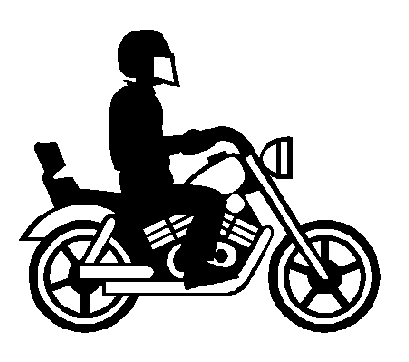
Parts Specifications
| Part | Numbers | Other Specs |
Front Tire |
3.50S18-4pr
Bridgestone S703
Dunlop F11
Yokohoma Y-992
ChengShin C906 100/90H18
|
Inflation: 24 psi
Min Tread: .06" |
| Rear Tire |
4.60S16-4pr
Bridgestone L302
Dunlop K127
Yokohama Y-987
ChengShin C907 120/90X16REA
|
Inflation: 28 psi
Min Tread: .08" |
| Battery |
12N12A
Challenger YB12A-A |
|
| Spark Plugs |
AC S121XL
Champion A-8Y
NGK D8EA
NipponDenso X24ES-U |
Gap: |
| Oil Filter |
Honda Part #154A1-413-005
|
Capacity: 2.6 qts |
| Air Filter |
Honda Part #HM447-AF
EMGO M914 |
|
Operational Specifications
| Idle speed |
1200 +/- 100 rpm |
Maintenance hints (tidbits gained from experience):
- Clockwise turn of idle adjust screw increases idle speed
- Clockwise turn of pilot screw produces a richer mixture
- When reinstalling fuel valve, tighten just until you can still twist the valve body by hand.
Turn the valve body so the fuel line nipple is pointed 90 degrees to the fuel tank and tighten with wrench until nipple
is slightly angled out from the fuel tank. If the nipple is pointed directly to the rear of the bike,
it will interfere with the left carburetor.
- To correct an inbalance in the carburetors, you need to do the "synchronize carbs" procedure.
During this procedure you need to adjust a screw in the middle of the carbs on the throttle plate.
This is much easier to reach if you open the throttle slightly to angle the screw forward until a small screwdriver and wrench can reach the screw and locknut.
If you can get a helper to hold the throttle slightly open, you will have two hands free to adjust the screw and locknut together.
- The method of removing the carbs shown in the Clymer manual is not the best.
I have found it better to remove both rear boots (to air cleaner), loosen the clamps on the front boots (to cylinder intakes), and slide the carbs out the left side of bike.
This gives you much more room to maneuver the carbs without stretching the throttle cables or pinching the rubber boots. In fact, if you suspect you may have to install/remove the carbs several times, it is well worth the effort to remove the rear fender and slide the whole air cleaner box with the boots attached to the rear a few inches while you work on the carbs.
- The Clymer procedure for changing the rear tire works (if you want to do-it-yourself - I am a tightwad, that's why I did) but it is not an easy job without proper tools. Anyway, Clymer says remove the right rear foot peg and exhaust -- don't bother, it doesn't make it any easier to remove the rear wheel. Also, remember to count the number of turns needed to remove the brake rod adjusting nut and you won't have to readjust it when you put it back on.
- If you change the front tire, you can avoid readjusting the brake by loosening just the front nut on the brake cable mounting bracket (at bottom of drum cover plate), run the nut all the way off the cable shield, unhook the cable from the brake actuating arm, slide the rubber collar forward until you can slide the cable to the rear and slip it out the slot in the mounting bracket. Be careful not to let the rear nut turn or the brake adjustment will be slightly off.
- When removing the torque link nut on the front wheel brake drum cover, be careful not to bend the retainer too much -- they are not easy to find and you will probably want to reuse it (there is no cotter pin here).
- If you have trouble getting the carbs adjusted for smooth engine operation, check the pilot screw adjust. I found out after much frustration that the screws had metal caps glued to them that were slipping and the pilot screw adjustment was not changing as I turned the cap. The cap is a plain round gray cap with a screw slot on top and a tab on one side for thumb adjustment. Over time the glue dries out and no longer grips the screw. You can simply remove the cap (carefully pry it off) and adjust the screw with a screwdriver. (Note: this is if you have the Kiehin carbs, I suppose there may be other designs)
- If throttle does not return but carb throttle cam moves freely when not connected to the throttle cable, you probably need to loosen the rear throttle cable adjustment. This isn't real obvious when you
install the cables (ie, it may look like they are positioned correctly, but the front cable may be pulling against the rear cable, causing the throttle to bind.
-
-
-
-
-
-
-
-
-
-
-
-
-
-
-
-
-
-
-
-
-
Wiring Charts
Diagrams being added. Each gif is a separate subsystem (these are relatively small gifs). There is interconnection between the subsystems. The abbreviation "p/o" in these diagrams means "part of".
This was necessary since several of the connectors and switches were part of multiple subsystems.
I have arbitrarily assigned numbers (from CN1 to CN22) to the various connectors on the bike. Eventually, I will put in a figure showing where each of these is located.
Ignition system
Starter
Headlight
Taillight
Instrument lights and horn
Turn Signals (ready by 2/1/99)

This page hosted by  Get your own Free Homepage
Get your own Free Homepage

